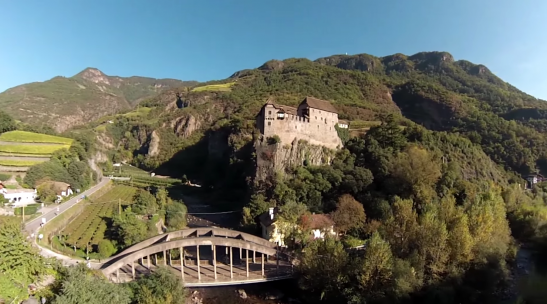
The illustrated castle. This is the most common name for Castel Roncolo, an elegant mediaeval castle that, from the high crag where it lies, overlooks the city of Bozen in South Tyrol.
Great part of its fame comes from its many frescoes about mediaeval times.
Many tourists coming in South Tyrol visit Castel Roncolo, known in German as Schloss Runkelstein. Tourists and travellers will admire the elegance of this mediaeval castle also known as the Illustrated Castle, because of its frescoes telling the then court life.
Its name comes from the crag where it was built. Such place, overlooking Bozen, was already well known in 1237asRunchenstayn. At the mouth of Val Sarentino, on the summit of the Talvera stream, close to the limits of the county of Renon, Castel Roncolo shows tourists all its beauty and its mediaeval characteristics.
The castle still keeps its original structure, unlike other castles in the surrounds, which were heavily restored and whose structure dramatically changed through the centuries. The castle is estimated to have been built in the thirteenth century, more precisely in 1237, on Beral and Friedrich von Wangen’s initiative.
The castle underwent several damages in 1274, as the Tyrolean Count Mainard II besieged it. The castle then passed to Gottschalk Knoger, a faithful servant of Count Mainard. The castle was rebuilt in the fifteenth century.
It was bought by Niklaus and Franz Vintler. The two brothers started to restore it in 1385. Frescoes were painted from1388.
The castle chapel was consecrated in 1390. Is eventually became property of Sigismund the Rich. Between1463 and 1465 the castle was borrowed to the Prince-Bishop of Trento.
In1500theTyrolean authorities gave the castle to Georg von Frundsberg, the famous reformer and commander of the Lansquenets, the soldiers obeying to the Hapsburg dynasty from Austria.
In1520the powder room exploded, causing damages to the structure and Frundsberg’s death. After the castle was totally restored in1531, in 1538 the von Liechtensteins became the new owners of Castel Roncolo. The Liechtenstein-Castelcorno branch took it as its official residence since 1574, changing part of its structure. The family Crest is still visible on the entrance door.
The Eastern part of the castle was destroyed by a fie in 1672, and was not rebuilt. The last descendant of the Liechtenstein-Castelcornos in 1759 refused the estate, de fact allowing the Bishop-Prince of Trento regain its control. Ludovic I, King of Bayern, stayed there in1833 and in 1880 the castle became property of John archduke, who gifted it to Franz Joseph, Emperor of Austria.
Today, Castel Roncolo belongs to the Municipality of Bozen, can be visited and is still a charming site with beautiful medieval frescos.